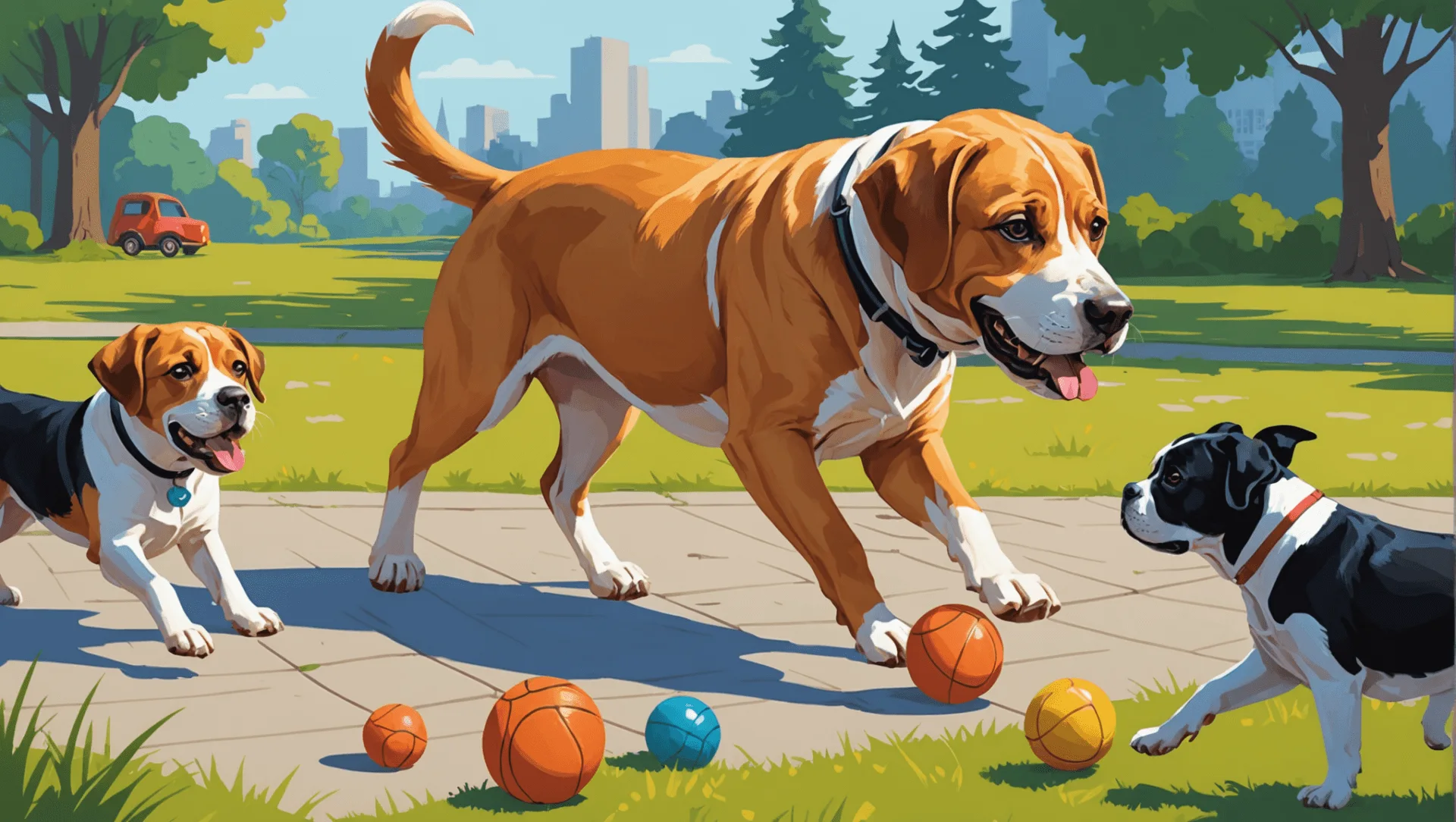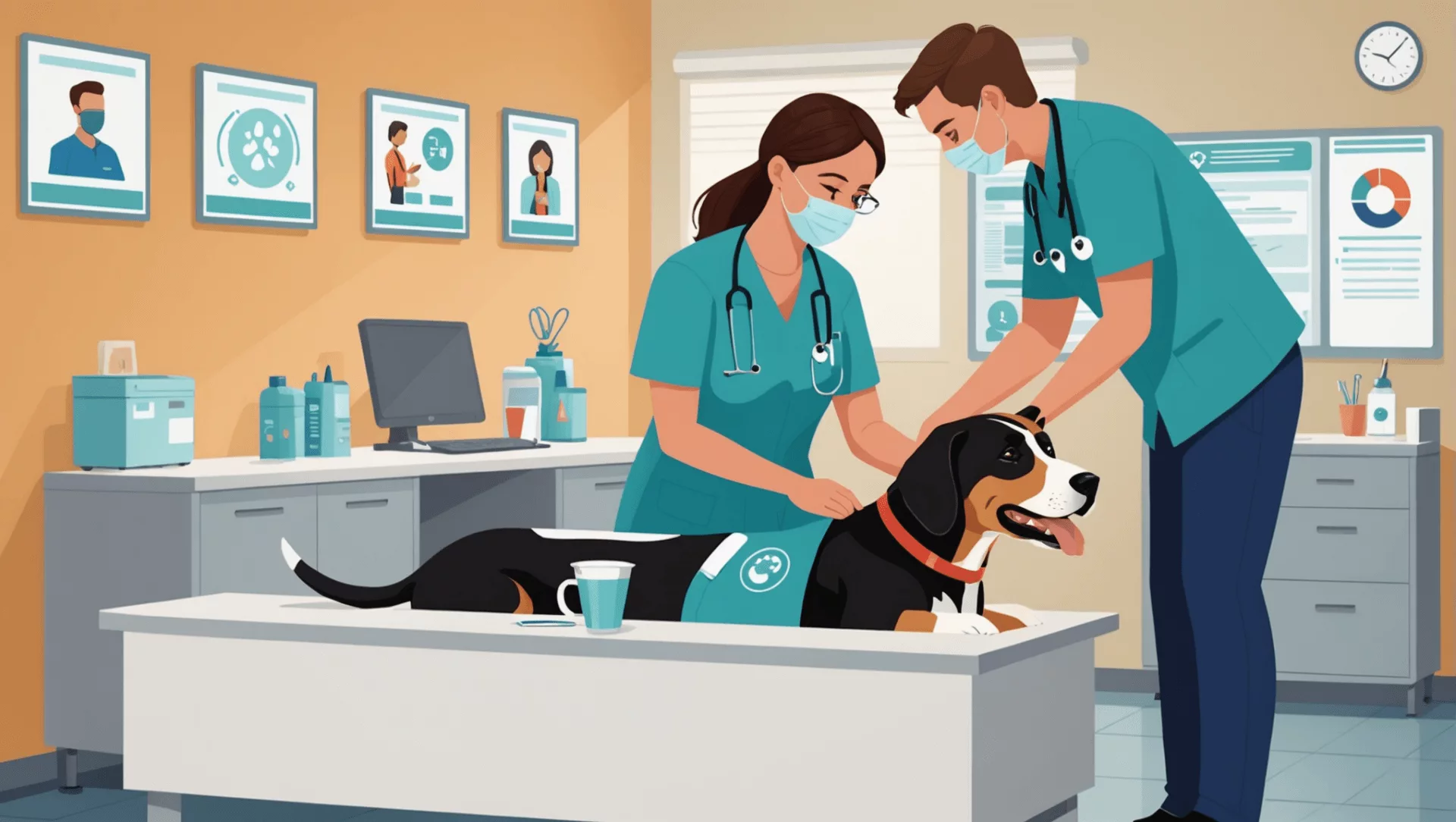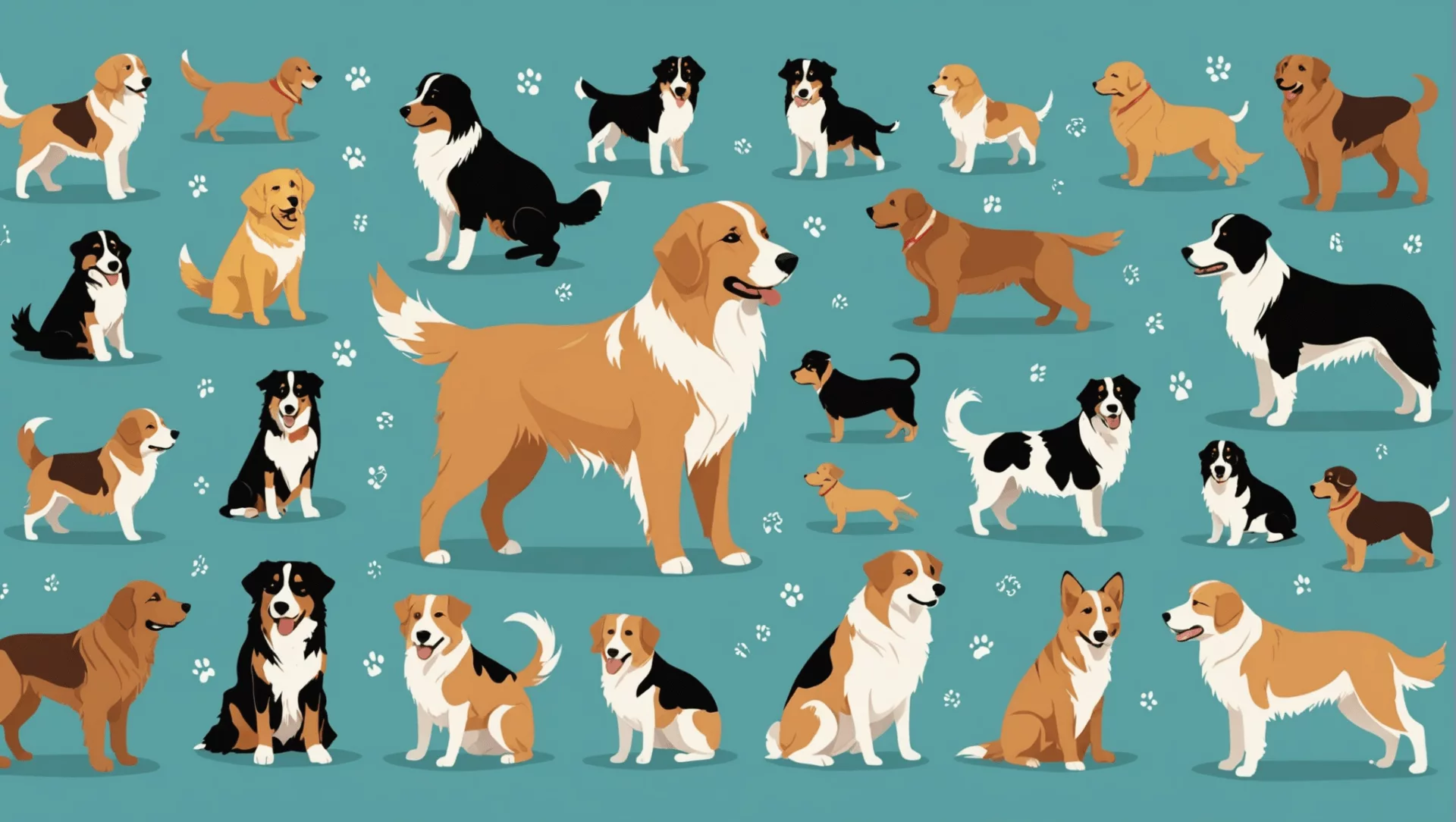Have you ever wondered what makes your furry friend so special? The Dog guide is here to help you unlock the secrets of your pup’s personality, care needs, and training tips! Understanding the different dog breeds and their unique characteristics is essential for every dog owner. Whether you’re a first-time puppy parent or a seasoned pro, knowing how to care for your dog can lead to a happier and healthier life for both of you.
Neglecting to learn about proper dog care could lead to behavior problems or health issues that can affect your best friend. In this guide, you’ll explore essential dog care principles, discover popular breed traits, and dive into the basics of dog nutrition. Get ready to embark on an exciting journey to become the best dog owner you can be! Let’s fetch the knowledge you need!

Understanding Dogs: The Basics
Understanding dogs is important for anyone who wants to have a happy and healthy pet. Dogs are not just pets; they are also our friends and companions. Learning about their traits, care, and needs helps us take better care of them.
What Makes Dogs Unique: Exploring Their Exceptional Traits
Dogs are social animals. They love being around people and other dogs. This social nature makes them loyal companions. They form strong bonds with their owners, which is why many people consider dogs to be part of their family.
- Dogs can be trained: they can learn commands and tricks. Training helps build a better relationship between the dog and its owner.
- Dogs have a strong sense of smell: they can smell things we can’t, helping them track scents and even detect emotions.
General Dog Care Principles: Essential Practices for Every Owner
Taking care of a dog means meeting their basic needs. Dogs need proper nutrition, exercise, and mental stimulation. Here are some key practices for every dog owner:
- Nutrition: Dogs need healthy food to grow strong. Feed them a balanced diet with protein, vitamins, and minerals.
- Exercise: Regular walks and playtime are essential. Exercise keeps dogs fit.
- Mental Stimulation: Activities like training and puzzle toys can keep their minds sharp.
Routine veterinary care is also very important. Regular check-ups help keep dogs healthy. They need vaccinations and parasite control to avoid illnesses.
Essential Dog Owner Tips: Practical Advice for New and Experienced Owners
Here are some helpful tips for dog owners:
- Use Positive Reinforcement: Rewarding dogs with treats or praise encourages good behavior. This method makes training fun and effective.
- Understand Body Language: Dogs communicate through body language. Knowing when a dog is happy, scared, or anxious can help owners respond to their needs.
By following these tips and understanding their unique traits, dog owners can ensure their furry friends lead a happy, healthy life.
Dogs are amazing creatures that bring joy and companionship into our lives. Learning about their traits and care helps us be the best owners we can be.
- American Kennel Club shows dogs are social animals and thrive on interaction.
- ASPCA explains that dogs need proper nutrition and regular exercise for a healthy life.
- Pet MD highlights the importance of understanding a dog’s body language for better communication.
- Humane Society emphasizes the value of positive reinforcement in training dogs.
By knowing these facts, we can create a loving environment for our pets.

Dog Behavior
Understanding dog behavior is very important for every dog owner. Dogs are more than just pets; they are family members. Knowing how they feel and act helps us take better care of them. In this section, we will look at common behavioral patterns, training methods, and how to identify and deal with problem behaviors.
Common Behavioral Patterns: Recognizing Key Traits
Dogs have some unique traits that make them special.
- Social Animals: Dogs are naturally social. They love to interact with people and other dogs. This social behavior helps them feel happy and secure.
- Body Language: Dogs talk without words. They use their body to express feelings. For example, a wagging tail often means happiness. If a dog growls, it might be scared or upset.
- Pack Behavior: Dogs see their human families as their pack. They look to their owners for guidance. Therefore, it’s important to be a good leader for your dog.
Understanding these traits helps us connect with our dogs better. American Kennel Club shows that social interaction is key for a dog’s happiness.
Training Fundamentals: Building a Strong Relationship
Training your dog is a great way to build a strong bond. Here are some effective methods:
- Positive Reinforcement: Rewarding your dog for good behavior is very effective. Use treats or praise when your dog does something right. This helps them learn what you expect.
- Consistency is key: Use the same commands and rules every time. This helps your dog understand what you want. For example, if you say “sit,” always use that word.
- Short Sessions: Keep training sessions short and fun. About 5 to 10 minutes is best for young dogs. This keeps their attention and makes learning enjoyable.
Using these training methods can improve your dog’s behavior. Fidelco Guide Dog Foundation explains that consistent training strengthens the bond between dogs and their owners. Moreover, regular training sessions help dogs learn essential commands and develop good manners, making them more enjoyable companions. Interestingly, understanding canine behavior can also provide insights into how dogs and their effect on snakes can be managed, especially in areas where wildlife encounters occur. By establishing a strong training routine, pet owners can ensure their dogs react appropriately in various situations, ultimately promoting safety for both the dogs and the wildlife they may encounter.
Problem Behaviors: Identifying and Addressing Issues
Sometimes dogs show behaviors that can be challenging. Here are some common problems and how to address them:
- Barking: If a dog barks a lot, it might be bored or anxious. More playtime and exercise can help reduce excessive barking.
- Chewing: Dogs often chew things when they feel bored or anxious. Providing chew toys can prevent them from chewing on furniture or shoes.
- Separation Anxiety: Some dogs get upset when left alone. Gradually training them to be okay with alone time can help. Start by leaving them alone for a few minutes and slowly increase the time.
Recognizing these issues helps owners find solutions. Waltham Petcare Science Institute states that understanding a dog’s needs is crucial for their well-being.
Knowing how to interpret dog behavior and how to train them effectively makes dog ownership a rewarding experience. By understanding and addressing common behaviors, we can create a happy home for our furry friends.

Dog Breeds: A Comprehensive Guide
Understanding dog breeds is important for anyone who wants to adopt a dog. Different breeds have distinct traits, care needs, and energy levels. This guide helps you learn about popular dog breed categories, how to choose the right breed, and specific care for different dogs. Knowing this will help you find the best furry friend for your home!
Popular Breed Categories: Understanding Group Characteristics
Dog breeds are grouped based on their traits and the jobs they do. This helps owners understand what each breed is like. Here are some common categories:
- Herding: These dogs, like Border Collies, help farmers move livestock. They are very smart.
- Working: Breeds such as Rottweilers and Siberian Huskies are strong. They often have jobs like guarding or pulling sleds.
- Sporting: Golden Retrievers and Cocker Spaniels are active dogs that love to hunt and play.
Knowing these categories can help you pick a dog that fits well with your lifestyle. The American Kennel Club shows that understanding these traits is key to choosing a friendly dog.
Choosing the Right Breed: Factors to Consider for Your Lifestyle
Choosing the right breed is crucial. You should think about your lifestyle before deciding. Here are some important factors to consider:
- Activity Level: Some breeds, like Labrador Retrievers, need a lot of exercise. Others, like Bulldogs, are more relaxed and need less activity.
- Living Space: Larger breeds usually need more room to move around. Smaller breeds can be happy in apartments.
- Time for training and grooming: Some breeds need regular grooming and training. Make sure you have enough time for this.
The Vetericyn Animal Wellness emphasizes that considering these factors will help you find a dog that fits your life perfect.
Breed-Specific Care: Tailoring Care to Individual Needs
Every dog breed has its unique care needs. Understanding these needs is important for their health and happiness. Here are some examples of breed-specific care:
- Nutrition: Large breeds like Great Danes may need special nutrients to grow strong and stay healthy.
- Health Issues: Some breeds are more prone to certain health problems. For example, German Shepherds can have hip dysplasia.
Taking care of your dog’s specific needs is essential. The information from AAHA highlights the importance of understanding these care requirements.
Interesting Facts
- Did you know there are over 340 dog breeds worldwide? Each breed has its unique traits and history!
- The Basenji dog is known as the “barkless dog.” Instead of barking, it makes a unique sound.
Conflicting Information
Many sources agree on dog categories and care needs. However, some information can vary. For instance, one source might say a breed is great for families, while another source might warn it could be too energetic. It’s essential to look at different sources and consider each dog’s personality when making your choice.
Further Exploration
- Exploring the history of dog breeds can be fascinating. Why were they originally bred? How have their roles changed over time?
- Learning about dog behavior and training can help new dog owners. Different breeds may require different training techniques.
Finding the right dog for your home can be a rewarding experience. By understanding dog breeds, you can make an informed choice that suits your lifestyle and brings joy to your life!

Dog Food: Nutrition Essentials for Your Pet
Understanding what to feed your dog is very important. Good nutrition helps your dog stay healthy and happy. This section covers the dog food available, how much to feed, and special diets for dogs with allergies.
Types of Dog Food: Dry vs. Wet and Everything In Between
There are different dog food to choose from. Each type has its own benefits.
- Dry Dog Food (Kibble): This food is crunchy and helps keep dogs’ teeth clean. It is usually less expensive and lasts longer than wet food.
- Wet Dog Food: This food is soft and has a strong smell that many dogs find appealing. It can be more expensive and doesn’t last as long as dry food.
- Mixed Feeding: Some pet owners feed both dry and wet food. This gives dogs variety and helps keep them hydrated.
According to the American Kennel Club, choosing the right type of food can affect your dog’s overall health.
Feeding Guidelines: How Much and How Often?
Knowing how much and how often to feed your dog is important too.
- The amount of food depends on your dog’s size, age, and activity level.
- Adult dogs should be fed twice a day. Puppies may need to eat three to four times a day.
- Always check the feeding guidelines on the dog food package. These guidelines provide specific recommendations based on your dog’s weight.
Veterinarians recommend following these guidelines to keep your dog healthy.
Special Dietary Needs: Catering to Food Allergies and Sensitivities
Some dogs have special dietary needs. This could be because of food allergies or sensitivities.
- Common allergies in dogs include beef, chicken, and grains. Symptoms can include itching or upset stomach.
- If your dog has allergies, it may need a special diet. This can include limited ingredient diets or hypoallergenic dog food, which has fewer ingredients.
The American Kennel Club advises pet owners to be aware of their dog’s reactions to food. If you notice any problems, consult your veterinarian.
Interesting Facts
Did you know that dogs have about 1,700 taste buds? Humans have around 9,000!
Also, just like us, dogs can be picky eaters. Some might love wet food, while others prefer dry food.
Remember, feeding your dog the right food is key to its health and happiness. Always choose high-quality dog food and pay attention to any signs of allergies.
For more information on dog nutrition, check out the guide from the American Kennel Club here.
By understanding dog food and its importance, you can help your furry friend live a happy and healthy life!

Dog Health: Keeping Your Best Friend Healthy
Taking care of your dog’s health is very important. Just like us, dogs need vaccinations, regular check-ups, and help when they are sick. Learning about these health topics can help every dog owner keep their furry friend happy and healthy.
Preventive Care: Vaccinations, Check-ups, and More
Preventive care is the first step in keeping your dog healthy. Vaccinations help protect dogs from dangerous diseases. Puppies usually need their first vaccines between 6-8 weeks old. After that, they get booster shots at different times in their lives.
Regular check-ups with the veterinarian are also very important. These visits help catch any health problems early. A vet will check your dog’s weight, teeth, and overall health. This way, your dog can live a long and happy life. American Veterinary Medical Association shows that regular veterinary care is essential.
Common Health Issues: Recognizing Symptoms Early
As a dog owner, it’s important to know about common health problems. Some dogs may get ear infections, dental disease, or become obese.
Signs of these problems can include:
- Scratching at their ears,
- Bad breath
- Trouble exercising or playing
If you notice these symptoms, take your dog to the vet for help. Catching these issues early can prevent more serious problems later. Pet MD shows that recognizing symptoms quickly can make a big difference.
Emergency Care Basics: When to Seek Professional Help
Sometimes, dogs can get very sick or hurt, and they need help right away. You should contact a veterinarian immediately if you see any of these signs:
- Difficulty breathing
- Severe vomiting
- If a car has hit your dog
Knowing when to act fast can save your dog’s life. American Kennel Club explains the importance of quick action in emergencies.
Interesting Facts
Did you know that dogs have about 1,700 taste buds? In comparison, humans have around 9,000! This means dogs taste things differently and may prefer certain flavors more than others. This fun fact shows how unique our furry friends are!

Dog Nutrition: Fueling Your Furry Companion
Dogs need good nutrition to stay healthy and happy. Just like humans, dogs require fresh foods to provide energy and support their growth. In this section, we will explore the essential nutrients dogs need, how their diet changes as they grow, and how to manage special dietary needs for dogs with health issues.
Essential Nutrients: What Every Dog Needs
Dogs need a balanced diet that includes:
- Proteins: These are important for growth and repairing body tissues. Excellent sources are meat, fish, and eggs.
- Fats: Fats provide energy and help absorb certain vitamins. Healthy fats come from fish oil or flaxseed oil.
- Carbohydrates: These give dogs energy and can be found in grains and vegetables.
- Vitamins and Minerals: Vitamins like A, D, E, and B help keep dogs healthy. Minerals like calcium and phosphorus support strong bones.
Feeding your dog a mix of these nutrients is crucial for their overall health. The American Kennel Club shows that a balanced diet helps prevent health problems.
Life Stage Nutrition: Adjusting Diet for Growth Stages
Different life stages require different diets. Here’s how to adjust your dog’s food as they grow:
- Puppies: They need a diet rich in proteins and calories. This supports their rapid growth and energy needs.
- Adult Dogs: Their diet should balance proteins and fats to keep a healthy weight.
- Senior Dogs: They often need fewer calories but may require more fiber to help with digestion.
As dogs age, their nutritional needs change. Always consult with a veterinarian to choose the best diet for your dog’s life stage. The VCA Animal Hospitals recommends this approach for maintaining a healthy dog.
Special Dietary Requirements: Managing Health Conditions
Some dogs have special dietary needs because of health issues. Here are a few examples:
- Allergies: Dogs with food allergies might need a hypoallergenic diet, which avoids certain ingredients.
- Diabetes: Dogs with diabetes need a consistent amount of carbohydrates to manage their blood sugar levels.
- Kidney Disease: These dogs may need special diets that are lower in protein and phosphorus.
It’s important to work with a veterinarian to create a suitable diet plan for dogs with health problems. The World Small Animal Veterinary Association supports this personalized approach for dietary management.
Understanding these nutritional needs will help you take great care of your furry friend. Always remember to provide fresh water and monitor your dog’s health. With a proper diet, your dog will feel great and have lots of energy to play!

Dog Temperament: Understanding Your Pet’s Personality
Understanding dog temperament is important for all pet owners. It helps you connect with your furry friend better. Knowing how your dog thinks and feels can lead to a happier home. Let’s explore the different aspects of dog temperament!
Understanding Different Temperaments: What to Expect
Dogs have unique temperaments, just like people. Some dogs are friendly and love to play with others. Others may be shy and prefer to stay close to their owners.
- Friendly Dogs: These dogs often enjoy meeting new friends. They may wag their tails and jump around excitedly.
- Shy Dogs: Shy dogs might hide or act nervous in new situations. They often need some extra love and patience.
Understanding these distinct personalities helps you know what to expect from your dog. This way, you can support them in the best way possible.
Breed-Specific Temperaments: Characteristics by Breed
Each dog breed has its own special personality traits. Knowing these traits can help you understand your dog better.
- Labrador Retrievers: These dogs are usually friendly and energetic. They love to run and play fetch.
- Bulldogs: Bulldogs are often calm and laid-back. They enjoy relaxing with their families.
Different breeds can have very different behaviors. Learning about your dog’s breed can guide you in caring for them better.
Managing Temperament Issues: Solutions for a Harmonious Home
Sometimes dogs may show signs of aggression or anxiety. This can be stressful for both the dog and the owner. The good news is that there are ways to help!
- Training: Teaching your dog basic commands can help them feel secure. Use positive rewards to encourage good behavior.
- Socialization: Exposing your dog to different people and places can help them become more comfortable. This can reduce shyness or fear.
- Professional Help: If your dog has serious issues, consider consulting a dog trainer or behaviorist. They can provide expert advice tailored to your dog’s needs.
With the right support, dogs can overcome many temperament challenges. This leads to a happier home for everyone!
Understanding dog temperament is vital for a strong bond with your pet. By recognizing unique traits and addressing potential issues, you can ensure your furry friend thrives in your home.
The Coronado Pet Hospital shows that understanding dog behavior helps owners provide better care.
Pet MD explains that training and socialization are key to managing a dog’s temperament.
The American Kennel Club emphasizes the importance of breed characteristics in understanding dog behavior.
The Arizona State University states that both genetics and the environment shape a dog’s temperament.
With this knowledge, you can make informed choices for your dog’s happiness and well-being!

Dog-Friendly Places: Exploring Together
Dogs are our best friends, and they love to explore just as much as we do! Finding dog-friendly places lets you enjoy time together outside. This section will help you discover where to take your furry friend, tips for traveling with them, and fun activities to do together.
Finding Pet-Friendly Locations: Where Can You Go?
Many parks, beaches, and trails welcome dogs. These spots are perfect for spending time with your furry friend. You can visit websites like BringFido and DogFriendly to find pet-friendly locations.
- Look for local parks that have dog areas.
- Check out beaches that allow dogs to run and play.
- Trails are great for walks and hikes with your dog.
Travel Tips with Dogs: Making Trips Enjoyable for Everyone
Traveling with your dog can be fun if you plan! Here are some tips to make your trip enjoyable:
- Pack essentials like water, food, and toys that your dog loves.
- Always check pet policies at hotels or other places you will stay. Some places may not allow dogs.
- Use a comfortable crate or seatbelt harness for safety during car trips.
Outdoor Activities: Fun Ways to Exercise Together
Staying active is important for both you and your dog. Here are some fun activities you can do together:
- Go hiking on trails that are dog-friendly. Make sure the trail is safe for your dog’s size and energy level.
- Take long walks in the park. This is a great way to explore new areas.
- Play fetch or frisbee in a dog park. It helps your dog burn energy and stay healthy.
Location Guides: Best Parks, Beaches, and Trails for Dogs
Here are some fantastic places to take your dog:
- Central Park, New York City: An extensive park with areas for dogs to play. Always check local leash laws.
- Golden Gate Park, San Francisco: This park has many trails and open spaces for dogs to explore, making it ideal for those with access to service animals.
Remember to check local rules about where dogs may go, especially in parks or beaches.
Sources like BringFido show many cities offer fun dog-friendly events, like “Yappy Hours,” for dogs to socialize with each other.
With these tips and locations, you and your dog can enjoy wonderful adventures together! Always check the specific rules for each place to make sure it’s safe and welcoming for your furry friend.

Round Ups: Dog Product Comparisons and Reviews
For caring for dogs, choosing the right products is very important. Many options are available, and it can feel overwhelming. In this section, we will look at dog product reviews, comparison guides, and the best-of lists. These tools help you make smart choices for your furry friend.
Product Reviews: Honest Insights on Popular Items
Product reviews are super helpful for dog owners. They show how well dog items work based on actual experiences from other pet owners.
- Understanding Product Reviews:
- Imagine reading stories from friends about their favorite toys. That’s what product reviews do for dog products! They help you figure out what items are worth buying?
- Why They Matter:
- Reviews help you see the pros and cons of dog products. This means you can make a better choice for your pet.
Comparison Guides: Weighing Options for Best Choices
Comparison guides are another great tool. They help you see the differences between dog products. This way, you can choose the best one for your needs.
- What Are Comparison Guides?
- Think of it like comparing two different video games to see which one you might like better. Each guide shows key features and prices.
- Making Informed Choices:
- These guides help you understand what each product offers. You can then find the best fit for your dog.
Best-of Lists: Top Picks for Essential Dog Gear
Best-of lists highlight the top-rated products based on reviews and expert opinions. These lists are like a treasure map for finding the best toys and gear for your dog.
- What Are Best-of Lists?
- It’s like a list of the coolest toys that everyone loves! Other dog owners have tested and recommended these products.
- Finding the Best Gear:
- Using these lists can save you time and effort. You can quickly find top choices without sorting through many options.
Summary of Insights
- Product Reviews: Help understand real user experiences.
- Comparison Guides: Show differences between products to help choose the best one.
- Best-of Lists: Curate top-rated products based on reviews and expert insights.
Finding the right products for your dog can make a big difference. Remember, just like picking the right toy, it’s important to choose wisely for your furry friend!
Dogs have been companions to humans for thousands of years, making them one of our oldest friends. According to the American Kennel Club, there are over 340 different dog breeds worldwide, each with its unique look and personality. Understanding these products can lead to a happier life for both you and your dog!
For detailed insights on dog food, health, and care, explore further sections in this guide. With the right information, you can ensure that your dog lives a happy and healthy life!
Conclusion
In this ultimate dog guide, we explored the wonderful world of dogs! We learned that dogs have unique traits that make them special companions. Understanding dog care principles, like providing the right nutrition and grooming, is also crucial for keeping your furry friend healthy and happy. Plus, recognizing different dog breeds helps you choose the best match for your lifestyle.
As dog owners, knowing how to understand behaviors and training methods can strengthen the bond you share with your pet. Whether you’re a first-time owner or a seasoned pro, there’s always more to discover in the amazing journey of dog ownership. So, keep learning and exploring the many aspects of caring for your best friend!

